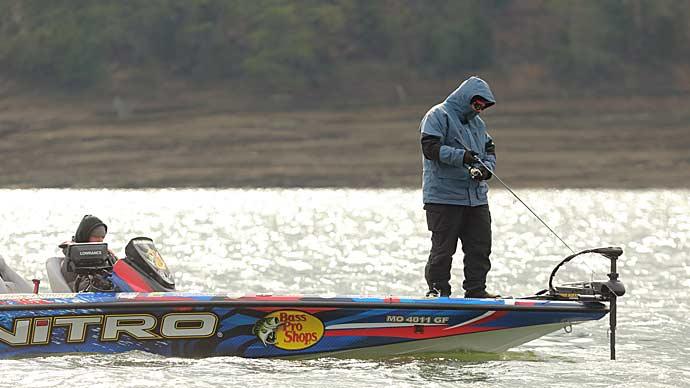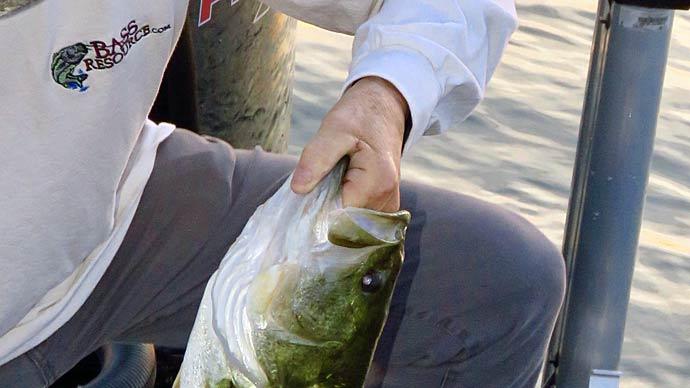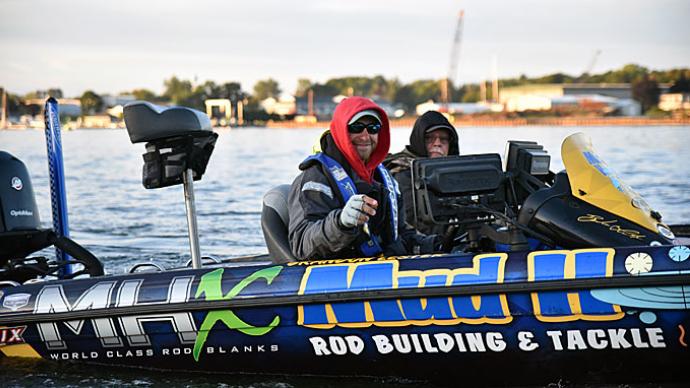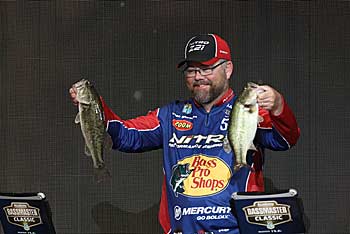
Settling in for the winter is a popular strategy, whether you’re a bear or a bass. While bass don’t hibernate, cold water does slow their metabolism. And less get-up-and-go is one reason they seem down to stay in one place from late fall through winter and into early spring. Bluffs are one of those places.
Rock faces that abruptly fall into deep water and bluffs are found throughout the bass range. They’re on the granite islands of the St. Lawrence River, which flows along the New York-Ontario, Canada, border and line the giant reservoirs of the desert West, where angling legend Don Iovino perfected his doodlin’ technique. And plenty are found on the highland reservoirs of middle America.
Fishing bluffs for bass is a tried-and-true tactic for Brian Snowden, a member of the Bassmaster Elite Series’ field from its first tournament in 2006 through the finish of its 2021 season when he stepped back from competition to pursue a different role with his longtime sponsor Bass Pro Shops. He lives in Reeds Spring, Missouri, which isn’t far from several of Ozark Mountain’s most-famous reservoirs, including Table Rock and Bull Shoals. And while they are great places to crank old-school Storm Wiggle Warts, they also are home to some of the best bluff fishing.
Main attractions
Bass are attracted to bluffs for a couple of reasons. First, their cracks, crevices, and deep water attract plenty of crawfish and baitfish. So, bass always find food. Second, they make it easy for bass to adjust to changing conditions. If they want to head shallow to take advantage of the relative warmth of a sunny winter day, they only have to float upward. And when conditions take a turn for the worse, they retreat vertically to find comfort at a deeper depth. For example, they might swim a great distance to reach a different depth if they were on a flat.
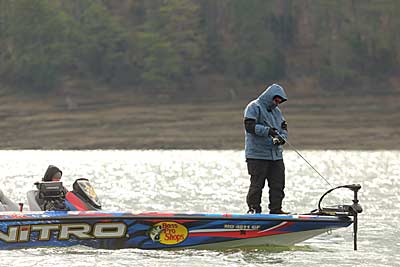
Snowden, who has almost 1.2 million dollars in B.A.S.S. tournament earnings, likes bluffs best for bass twice a year. The first is during the summer heat, when he works topwaters along them first thing in the morning, mopping up any bass that moved shallow overnight but have yet to return to their deeper daytime haunts. He likes them during winter, from start to finish. Mid to late spring is the only time they don’t seem to produce. He said most of their bass leave, heading to nearby shallow flats to spawn.
The bluffs on Snowden’s home waters share many physical similarities with bluffs everywhere. They’re found close to and in the main lake, and they almost always sit on the outside of river-channel swings. He said some bottom out in more than 100 feet of water, and others are near standing timber. But that doesn’t mean they all produce bass from end to end.
Focusing on specific spots is the key to catching the most bass from a bluff. “Our [bluffs] have jagged points and rock slides,” he said. “The ones that have more rockslides and sharp points are better. There may be like 15 points and two or three rock slides [on one bluff]. None of them are perfectly straight.” But the main attraction — for him and the bass — is the ledges.
Envision ledges as the treads on a staircase. While not always following one after another at a set interval, they give bass places to hold and feed as they move shallower and deeper in response to current conditions. “There often will be two or three ledges before you get to 30 to 40 feet deep,” Snowden said.
Most of these sweet spots are only big enough for a bass or two. Snowden said that means picking off a bass here and there. But at the ends, about the first 50 yards, he says you can find schools of them. “That’s normally where you find those,” he said.
Stay close
Snowden will slide close to a bluff and cast parallel to its face during a particular part of the year. “We do some with a crankbait, and that would be in the spring,” he said. But the rest of the time, he makes perpendicular casts. They make it easier to pick apart their points and slides. It also allows him to fish several ledges — each at a different depth — on every cast. That adds efficiency to his fishing.

After your lure lands next to the bluff, let it sink to the first ledge, which may be only 5 or 6 feet deep. Then using your rod tip, slide your lure off that ledge and let it fall to the next, which may be down 10 feet. Snowden said that process can be repeated down to about 25 feet without ever releasing more line from your reel. “A lot of times, you can work a bluff and barely move your reel handle,” he said.
Follow your lure’s descent with your rod’s tip. Snowden said it’s essential to keep a semi-taunt line. A bit of slack will let your lure work without deadening your ability to detect light bites. That feel is how he finds most bass living around bluffs. While forward-facing sonar, such as Garmin LiveScope, will help you identify individual ledges and define points and rock slides, it doesn’t reveal many bass on this type of structure. He said bass are usually tucked too tightly to be discerned on screen.
Best baits
Specific lures are easier to fish tight to bluffs. They must be heavy, so they sink straight down instead of pendulum toward your boat. “When I fish them, I tend to use a jig or Texas-rigged worm,” Snowden said. He usually reaches for a 5/8- or 3/4-ounce jig. His worms are usually rigged with a 1/2-ounce weight, though sometimes he selects a lighter 3/8-ounce version when bass are holding on the shallowest portions of a bluff. Try using a tungsten bullet weight. They are denser and smaller than lead weights of equal weight, creating a more natural profile for your lure and efficiently moving through the cover.
Plastic worms are a good choice for fishing bluffs. While their heavy weight keeps them close to the bluff, you can adjust the sink rate by selecting a different tail style. Need a fast-sinking one that generates reaction strikes from sluggish bass or in clear water? Choose a worm with a straight or hooked tail. Want to give bass in dirty water an easy-to-find target? Then use a worm that has a big swimming tail that moves plenty of water. The exact process can be used for selecting trailers for your jig.
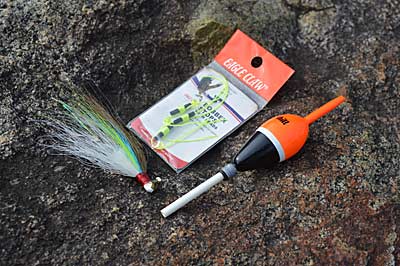
While Snowden doesn’t watch for bass on his electronics while fishing bluffs, he does keep a close eye on the water temperature reading they provide. He takes note when it bottoms out at its coldest point, then waits. He said bass will suspend off a bluff when it warms up 3 or 4 degrees. Then he puts down his bottom-bouncing baits and picks up a jerkbait or float-n-fly. The latter has produced plenty of bass for him in the 2- to 4-pound range, and he’s heard it being credited for five-bass limits in tournaments that weighed in the low 20-pound range. He often switches to an umbrella rig when he hunts bigger bass.
Born in the hills of Tennessee, the float-n-fly takes cold water finesse fishing to the next level, especially when the sky is bright and the water’s surface slick. Rigging requires some items that aren’t necessarily associated with bass fishing. The first is a slip float — the slender balsa versions most often used by walleye and crappie anglers. The other is a lightweight jig tied with a bucktail or marabou that resembles a small minnow.
Completing the float-n-fly, fished on a long wispy spinning rod and light-weight line, is a bobber stop, such as those used to lock bullet weights in punching rigs. Use it to adjust how far your jig swims below your float. You’ll want it slightly shallower than the suspended bass you’re targeting.
Once you’ve put your float-n-fly into position, there isn’t much more to fishing it. Any breath of wind or wave size will move your float, and that motion will transfer to your jig. Those slight movements will be magnified by your jig’s hair or marabou, making your offering look alive.


